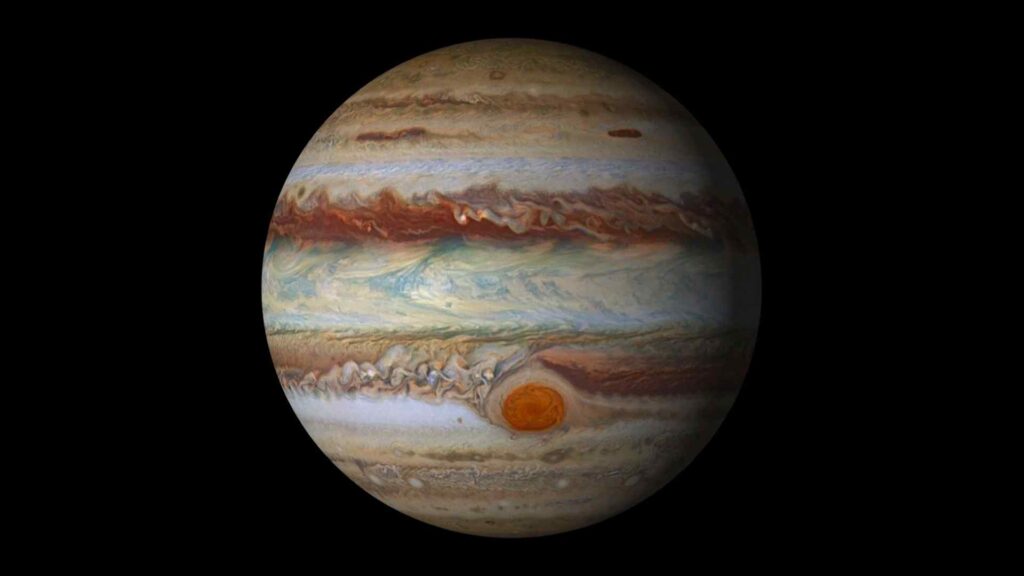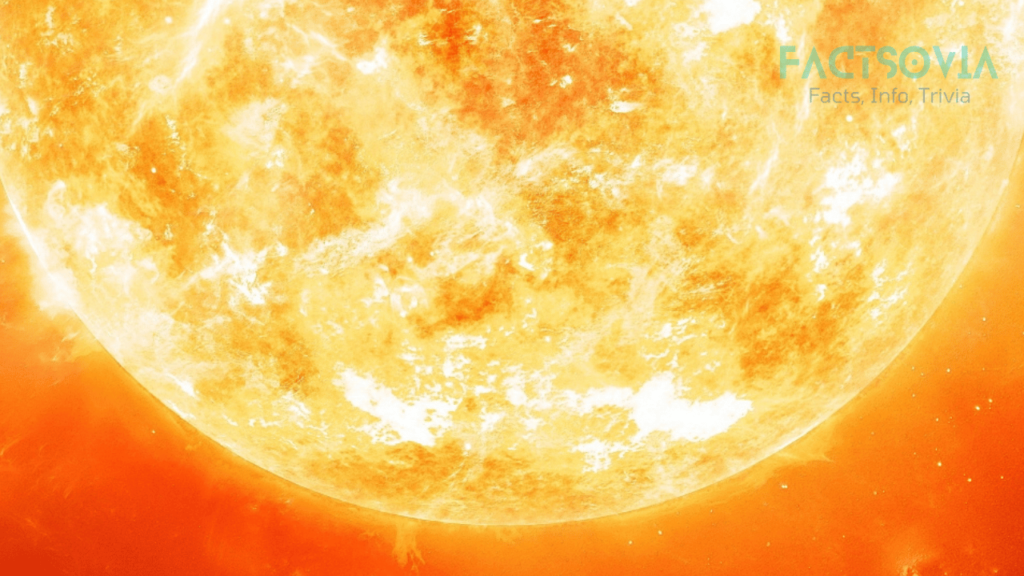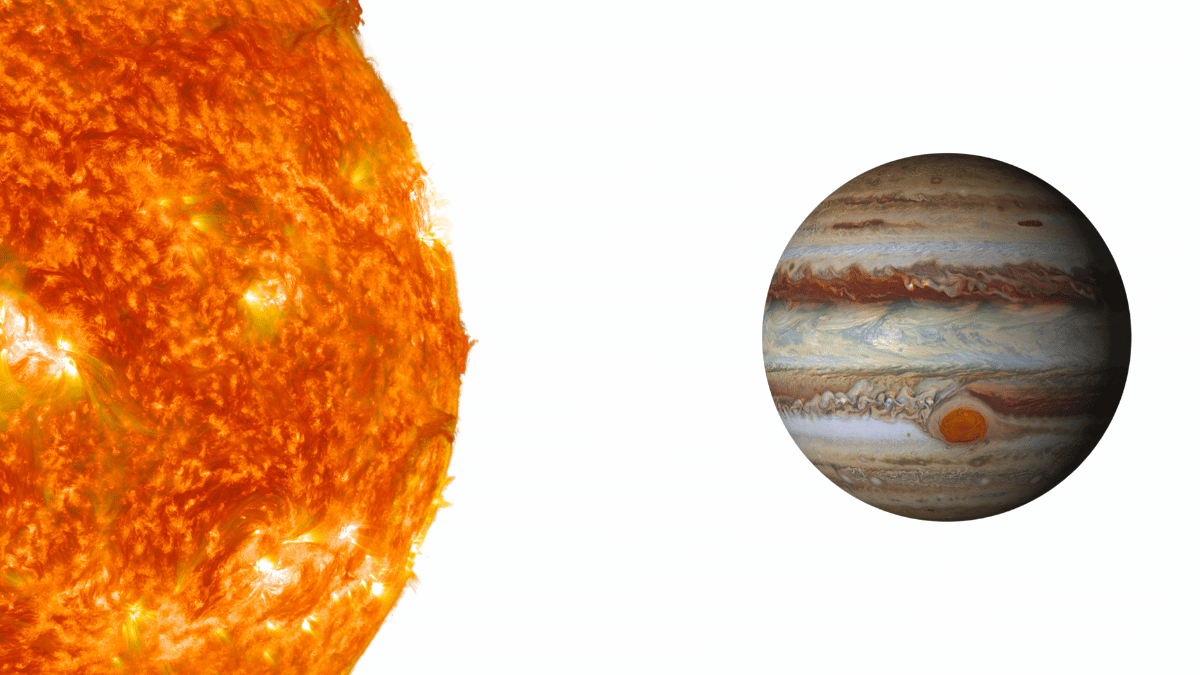We use affiliate links to run our site. When you buy through links on our site, we may earn an affiliate commission, without any added cost to you. Learn more
Our minds struggle to grasp the true scale of our solar system. We gaze up at the Sun’s fiery surface and Jupiter’s colorful cloud bands, but do we truly comprehend the immensity behind what we’re seeing?
What if I told you over 980 Jupiters could squeeze inside the Sun’s massive core? Let that sink in…980 planets the size of Jupiter crammed wall-to-wall in a cosmic game of sardines. I did the math, and trust me, the real proportions of the Sun compared to Jupiter will melt your brain!
Join me on an imaginative journey to fathom the dizzying dimensions separating these two titans of our solar neighborhood.
You’ll come away with a whole new appreciation for just how huge our celestial neighborhood truly is!
Table of Contents
Jupiter – The Largest Planet
First, let’s survey the size of Jupiter, the heavyweight planet of our solar system. Jupiter is the fifth planet from the Sun and the most massive of all. This gas giant boasts vivid cloud bands and raging storms including the iconic Great Red Spot, a centuries-old crimson vortex larger than Earth.

- Diameter at equator: 142,984 km
- Polar diameter: 133,709 km
- Volume: 1.43128×1015 km3 – 1,321 Earths could fit inside
- Mass: 1.898 × 10^27 kg – 317 times Earth’s mass
- Surface area: 6.1419×1010 km2
Jupiter is over 11 times wider than Earth and contains 2.5 times the mass of all other planets combined. Truly Jupiter dominates its planetary rivals in size and volume. But how does it compare to the Sun?
The Sun – A Star of Gargantuan Proportions
The Sun lies at the heart of the solar system and contains 99.8% of the mass within it. This star anchors the planets in orbit through its immense gravitational pull.

- Diameter: 1,391,400 km – 109 x Jupiter’s diameter
- Circumference: 4,366,813 km
- Volume: 1.41 × 1018 km3
- Mass: 1.989 × 10^30 kg – 333,060 x Jupiter’s mass
The Sun’s width is over 100 times greater than Jupiter’s. If Jupiter was hollow, 1.3 million Earths could fit inside! The Sun clocks in at over 300,000 times more massive than Jupiter. Clearly, the Sun is no average star, but rather a celestial mammoth.
How Big is Betelgeuse Compared to The Sun?
Calculating How Many Jupiters Can Fit Inside the Sun
With their dimensions in mind, we can mathematically determine how many Jupiters could fit inside the volume of the Sun.
- Volume Sun: 1.41 × 1018 km3
- Volume Jupiter: 1.43128×1015 km3
- 1.41 × 1018 km3 / 1.43128×1015 km3 = 984
About 984 Jupiters could fit in the Sun’s expansive core! Picture almost 1000 planets the size of Jupiter crammed inside. While the Sun dwarfs Jupiter in every way, an unfathomable number of Jupiters would be needed to equal the Sun’s scale.
Jupiter’s Distance from the Sun
Though Jupiter orbits near the Sun cosmically, the actual distance between them is immense:
- Average orbital distance: 778.6 million km
- Closest to Sun: 588 million km
- Farthest from Sun: 968 million km
To complete one orbit, Jupiter travels about 4,332.6 million km over 11.86 Earth years. At its fastest, Jupiter zips around the Sun at a mere 13.07 km/s. While tiny compared to light speed, in human terms Jupiter still outraces our fastest spacecraft.
Jupiter may appear close to the Sun in the sky, but it lies far across the reaches of our solar system. The outer gas giants dwell incredibly distant from the Sun’s warmth and light.
How far is Jupiter From Planet Saturn?
Comparing the Sun and Jupiter’s Structure
The Sun and Jupiter share some similarities in composition and internal structure:
- Both are primarily composed of hydrogen and helium.
- They contain cores of heavier elements surrounded by envelopes of swirling gases.
- Powerful internal convection currents manifest as surface storms and features.
However, the Sun fulfills the criteria for a main sequence star while Jupiter is categorized as a gas giant planet.
The Sun’s mass enables hydrogen fusion in its core, making it a true star. Jupiter lacks sufficient mass for fusion so is not stellar in nature.
Still, with shared building blocks and stormy exteriors, Jupiter does mimic its brilliant host star in miniature form.
Conclusion
I hope visualizing the Sun crammed with 984 Jupiters gave you cosmic scale goosebumps! Understanding the dizzying size differentials in our solar system makes me feel so small, but also fills me with awe. I’d love to hear your mind-blowing revelations in the comments below!
Don’t forget to share this post if you want to scramble someone else’s brain with just how giant our Sun is compared to Jupiter.
To continue exploring the mysteries of space, check out some of my other articles comparing the sizes of celestial objects.
You can also learn about Jupiter’s composition, the Sun’s internal structure, and more by delving into our astronomy blog posts. Stay curious, my friends. Our universe is full of wonders!
Amazon and the Amazon logo are trademarks of Amazon.com, Inc, or its affiliates.
